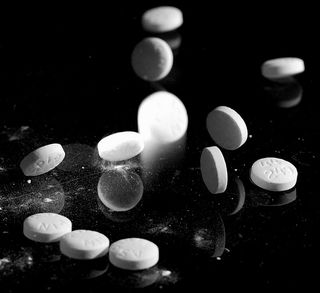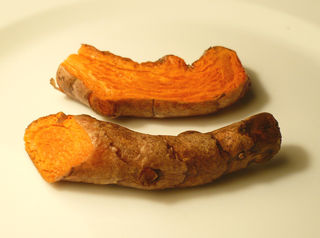Depression
Effective Non-Toxic Alternatives for Pain and Depression
Say no to NSAIDS.
Posted November 7, 2017

By now we have all heard about the dangers of non-steroidal anti-inflammatories, (NSAIDS) but what are effective alternatives to treat pain and inflammation that co-occurs with depression and PTSD? There are very effective alternatives called Herbal NSAIDS that work in similar ways to OTC and prescription NSAIDS to reduce inflammatory processes in the body that cause pain and contribute to depression. Below I will provide some options you may rely upon.
What are NSAIDS?
NSAIDS are non-steroidal anti-inflammatories that include aspirin, ibuprofen (Advil, Genpril, IBU, Midol, Motrin, Nuprin), diclofenac, and naproxen (Aleve, Midol Extended Relief, Naprelan 375, Naprosyn).
Dangers of NSAIDS
NSAIDS increase the risk of heart attack and stroke (Bally Dendukuri Nandini, Rich Benjamin, Nadeau, Helin-Salmivaara, Edeltraut et al. 2017) though evidence does not support the same risk with aspirin. NSAIDS are also one of the major causes of liver damage (Besson, 2010). Chronic use of non-steroidal anti-inflammatory drugs (NSAIDS) can also cause bacterial overgrowth in the intestines called SIBO, small bacterial overgrowth (Muraki et al., 2014) leading to digestive problems and chronic illness. NSAIDS can increase gut permeability; this means that your intestinal walls become like your old dish sponge that you have used until it has fallen apart. Instead of being nice and tight with holes that allow liquid to pass, the sponge (your intestines) has become rough, torn, inflamed and frayed allowing proteins to permeate the walls into the bloodstream. Intestinal permeability contributes to chronic illness both mentally and physically.
NSAIDs also interfere with antidepressant efficacy and are associated with damaging joint cartilage and causing gut and kidney damage. NSAIDS deplete folic acid, B6 and B12, vitamin C, calcium, and magnesium. An occasional use of NSAIDS is not a problem. They become problematic when used regularly.
The great news is that herbal medicines and nutrients provide effective anti-inflammatory and pain relief, without the side effects.
Effective Herbal Alternatives to NSAIDs
One of my favorite commercially available natural NSAIDS is called KappaArrest which is a blend of curcuminoids (turmeric extract), Boswellia serrata extract, propolis, green tea extract, ginger extract, rosemary extract, celery seed extract, resveratrol, alpha-lipoic acid, Phytolens, and Piper nigrum another is a commercial product called Sculacia
Sculacia
Sculacia is made from Chinese skullcap and Acacia catechu. Chinese skullcap is a member of the Lamiaceae (mint) family and native to China. This plant contains antioxidants known as flavones: in particular, baicalin and baicalein. Combined, the extracts of flavonoids from Scutellaria baicalensis and Acacia catechu, inhibit the two pro-inflammatory COX and LOX enzymes to reduce production of pro-inflammatory eicosanoids (Burnett, Jia, Zhao, & Levy, 2007). Scutellaria baicalensis also promotes normal cellular growth (Chi, Lim, Park, & Kim, 2003 ). Combined together in capsule form, they are effective for pain.

Green tea
Green tea (Camellia sinensis) is an important anti-inflammatory and anti-depressant. A unique amino acid found in green tea is Theanine (glutamic acid gamma-ethylamide). Human studies have demonstrated that dietary theanine supplementation increases alpha wave activity (Yokogoshi, et al., 1998) and fosters a state of alert relaxation. Theanine stimulates GABA and serotonin production and is a relaxing anti-inflammatory beverage. It crosses the blood-brain barrier and has been shown in studies to increase levels of dopamine, the pleasure chemical in the brain. Theanine is a glutamate antagonist and suppresses glucocorticoids which may account for its action as an antidepressant (Paul & Skolnick, 2003). Green tea is also a powerful antioxidant and is associated with longevity. The L-theanine and caffeine found in green tea appear to significantly improve memory and attention much more than caffeine alone (Owen, Parnell, De Bruin, & Rycroft, 2008).

Cooking with Ginger and Turmeric
Ginger and turmeric inhibit COX and LOX, which are enzymes responsible for inflammation in the body. These are cost-effective medicinal rhizomes that can easily be integrated into daily tea and food preparation. Ginger root is especially effective for joint and muscle pain in part due to gingerols (relatives to capsaicin and piperine found in chilies and black peppercorns), which inhibit the COX and LOX inflammatory enzymes. These rhizomes are available in liquid extract or capsules. A large double-blind study demonstrated that curcumin (from Turmeric) was as effective as the powerful anti-inflammatory drug (phenylbutazone) in reducing pain, swelling, and stiffness in rheumatoid arthritis patients (Meschino, 2001).
Turmeric comes in powdered form and as a fresh root and both can be used for cooking. One way to benefit from the synergistic effects of turmeric and ginger is to obtain both fresh roots (generally found at Indian, Asian, or health food stores) and to cut up about a 2 inches worth of each and boil in water for 15 minutes until it’s a nice bright orange. Drink 2 cups a day. Piperine, found in black pepper is required for the optimal absorption of curcumin, and it is often added to curcumin capsules and used in cooking for this reason.
Try this delicious recipe for your daily dose of turmeric.
Golden Milk
Golden Milk is a traditional Ayurvedic beverage named for the rich golden color of turmeric. It can be purchased or made at home. It combines powdered turmeric with spices that lift the mood as they decrease pain.
Combine Ingredients
2 cups fresh almond or coconut milk
1 tsp coconut oil (optional)
2 tsp turmeric powder
¼ tsp cardamom powder
½ tsp ground cinnamon
½ tsp fresh chopped ginger
¼ tsp black peppercorns or 1/4 tsp fresh ground pepper
3 drops vanilla or piece of vanilla bean
Add all ingredients to a saucepan and simmer for 5 minutes. Use a frother or whisk to blend well until hot. Sweeten with a few drops of stevia or a little raw honey. I love Gaia Herb Golden Milk.
Herbal Analgesics
Combining white willow bark (Salix alba), devil’s claw root (Harpagophytum procumbent), and Boswellia serrata provides another option for an effective analgesic. Boswellia serrata is a traditional Ayurvedic anti-inflammatory for the treatment of arthritis. It is both anti-inflammatory and analgesic and inhibits the 5-lipoxygenase enzyme in white blood cells (Meschino, 2001). Devil’s claw root is also anti-inflammatory, and white willow bark extract contains salicin, which is effective in the treatment of arthritis, back pain, and other joint inflammatory conditions (Meschino, 2001). Some people are sensitive to salicylates and should avoid willow bark. You may gather these herbs at a local herb store or purchase this combination commercially, called Bio-Allay.
Topical Pain Relief
When pain is localized, as in some neuropathic pain or pain from Shingles, the use of topic applications that are herbal-only or combine herbs with NSAIDs can be very effective. The benefit of topic use is the reduced effect on systemic oral use of NSAIDS and targeted effect on pain. The Topical application of capsaicin is very helpful for localized muscular, joint, or scar pain. Capsaicin is the active component of cayenne pepper (Capsicum frutscens) and it stimulates and then blocks pain. One can obtain a specially compounded gel at a compounding pharmacy.
Compounding Pharmacists can also formulate topical creams or gels that contain compounds like ketoprofen (NSAID), ketamine, and capsaicin for neurological pain or for treatment of pain due to fibromyalgia.
Conclusion
There are many commercial and homemade option to help the body reduce inflammation which causes pain and depression. Work with a clinician specializing in these natural approaches to reduce negative side effects for long-term relief and recovery. I explore many of these options and more, in my books Nutrition Essentials for Mental Health and Rhythms of Recovery: Trauma Nature and the Body
References
Bally Michèle, Dendukuri Nandini, Rich Benjamin, Nadeau Lyne, Helin-Salmivaara Arja, Garbe Edeltraut et al. (2017) Risk of acute myocardial infarction with NSAIDs in real world use: bayesian meta-analysis of individual patient data BMJ 2017; 357 :j 1909
Bessone, F. (2010). Non-steroidal anti-inflammatory drugs: What is the actual risk of liver damage? World Journal of Gastroenterology : WJG, 16(45), 5651–5661. http://doi.org/10.3748/wjg.v16.i45.5651
Burnett, B. P., Jia, Q., Zhao, Y., & Levy, R. M. (2007). A medicinal extract of Scutellaria baicalensis and Acacia catechu acts as a dual inhibitor of cyclooxygenase and 5- lipoxygenase to reduce infl ammation. Journal of Medicinal Food, 10 (3), 442–451.
Chi, Y. S., Lim, H., Park, H., & Kim, H. P. (2003). Effects of wogonin, a plant flavone from Scutellaria radix, on skin inflammation: In vivo regulation of inflammation associated gene expression. Biochemical Pharmacology, 66 (7), 1271–1278.
Meschino, J. P. (2001). Natural anti-inflammatory supplements: Research status and clinical applications. Massage Today, 1 (12). Retrieved from http://massagetoday. org/mpacms/mt/article.php?id=10369
Muraki, Motoko & Fujiwara, Yasuhiro & Machida, Hirohisa & Okazaki, Hirotoshi & Sogawa, Mitsue & Yamagami, Hirokazu & Tanigawa, Tetsuya & Shiba, Masatsugu & Watanabe, Kenji & Tominaga, Kazunari & Watanabe, Toshio & Arakawa, Tetsuo. (2014). Role of small intestinal bacterial overgrowth in severe small intestinal damage in chronic non-steroidal anti-inflammatory drug users. Scandinavian journal of gastroenterology. 49. . 10.3109/00365521.2014.880182.
Owen, G. N., Parnell, H., De Bruin, E. A., & Rycroft, J. A. (2008). The combined effects of L-theanine and caffeine on cognitive performance and mood. Nutritional Neuroscience, 11 (4), 193–198.
Paul, I. A., & Skolnick, P. (2003). Glutamate and depression: Clinical and pre clinical studies. Annals of the New York Academy of Sciences, 1003 , 250–272. 6241-006-BM1-1pass-r03.indd 290 9/6/2012 7:50:22 PM




